Get set for the Global Immersion programmes
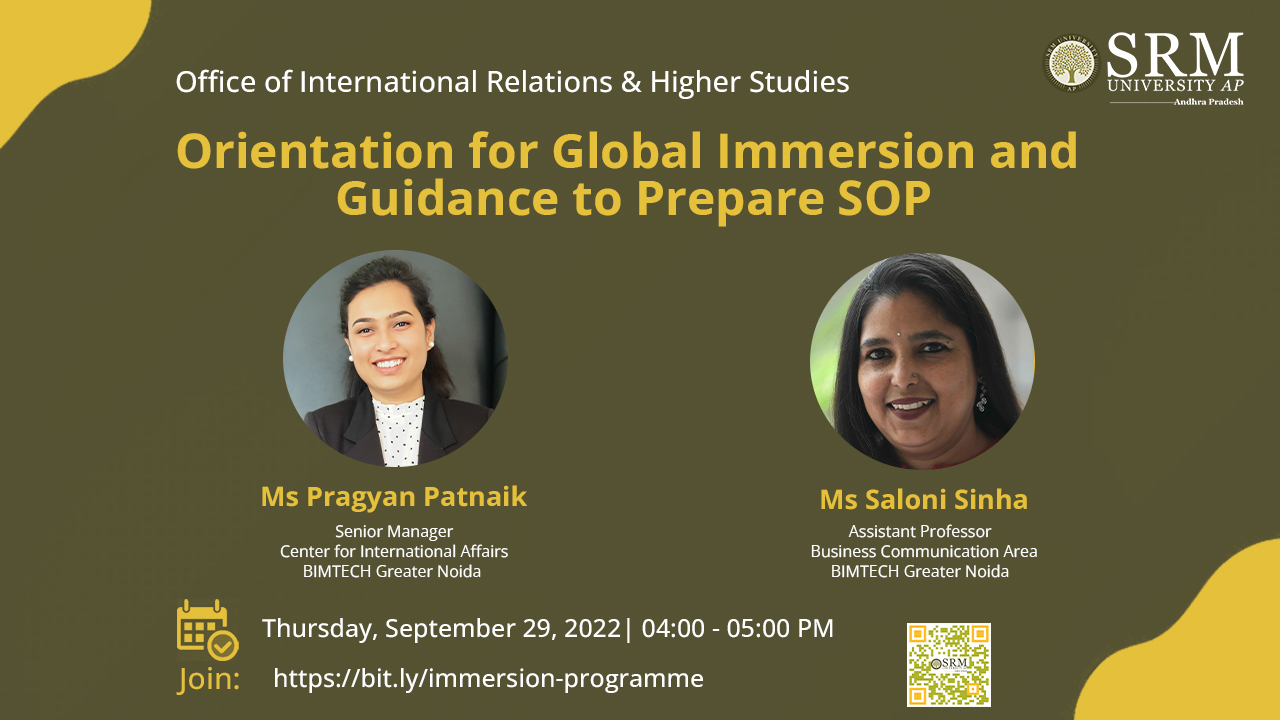
The Office of International Relations and Higher Studies is organising a session titled Orientation for Global Immersion and Guidance to Prepare SOP to enable students to lay the groundwork for their abroad learning programmes with a resounding Statement of Purpose. Ms Saloni Sinha and Ms Pragyan Patnaik from the Birla Institute of Management Technology will address the gathering.
Date: September 29, 2022
Time: 4.00 pm to 5.00 pm
A Statement of Purpose (SOP) is one of the most substantial pieces of evidence to facilitate your abroad learning. The clarity it exudes will define your needs and goals in pursuing the programme. Unfortunately, students are struggling to put together an SOP owing to their lack of clarity in drafting the document. This session intends to cast light on all the prerequisites for abroad education and will train students to compose a convincing SOP.
Speakers’ Profile
Ms Saloni Sinha is a faculty of Communication & Future Skills at the Birla Institute of Management Technology, India. She is a gold medallist in Linguistics from Jawaharlal Nehru University, New Delhi. She works in the domain of enhancing capabilities through her innovative teaching in the field of Communication, Theatre, Future skills, development communication and Intercultural Communication. Her research interests include employability skills, innovative classroom pedagogy, intercultural communication, corporate communication, development communication, education technology and translation. Ms Saloni has recently developed a novel SINHA’s COVID SEL 5X7 Matrix, a socio-emotional learning framework for educators. She is the recipient of the Youth Icon Award 2018 for her Theatre for Social Change initiatives. Ms Saloni is also empanelled as a casual translator in the Prime Minister’s Unit at the Press Information Bureau of the Government of India.
Ms Pragyan Patnaik takes an active interest in the Internationalisation of Higher Education Institutions. With more than a decade of international experience, her stint in the field began during her time as a Researcher in one of the leading Institutes of Technology in Germany – Leibniz University Hannover, in 2010. She has served in the field of Internationalisation of HEIs in various capacities in leading German universities, establishing academic and cultural bridges between India and Germany. She is the recipient of the prestigious Deutscher Akademischer Austauschdienst (DAAD) Fellowship, Germany. Prior to BIMTECH, she served with a premier Indian institution and was responsible for developing the University’s International Relations Office and leading international programs.
- Published in Events, International Relations, IR-Events
How to craft your first Research Paper!
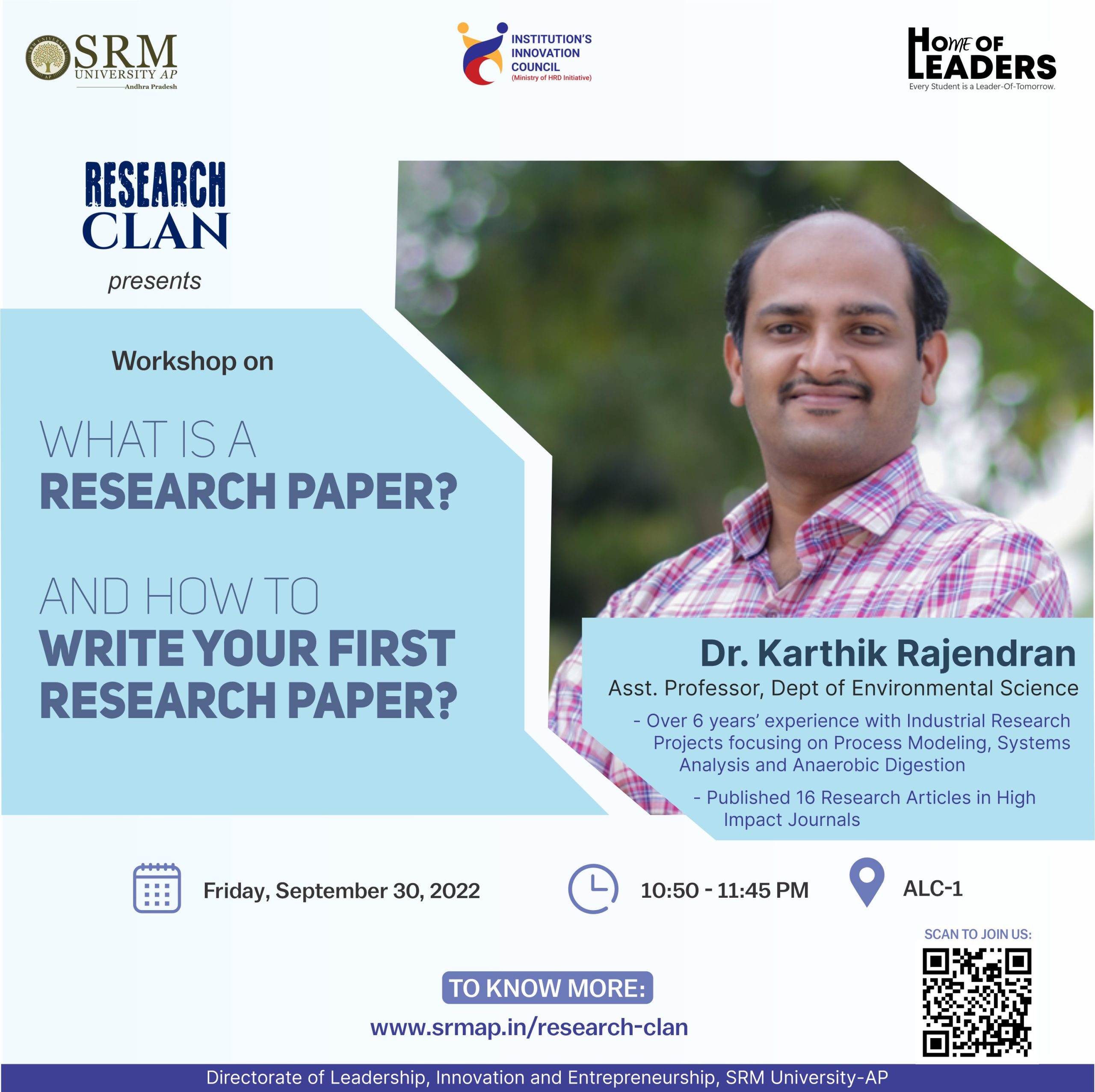 Propagating a novel finding to a general or focused audience requires an appropriate medium. Research papers serve this purpose by popularising your ideas and preventing them from duplication by a third party. They provide analysis, interpretation, and evaluation of anything and everything based on in-depth independent research. However, many research enthusiasts do not have a clear picture of how to craft a solid research paper. Research Clan, an initiative of the Department of Entrepreneurship and Innovation, is back with an exciting workshop on What is a research paper and how to write your first research paper. Dr Karthik Rajendran, Assistant Professor, Department of Environmental Science, will be guiding the students in writing an impactful research paper.
Propagating a novel finding to a general or focused audience requires an appropriate medium. Research papers serve this purpose by popularising your ideas and preventing them from duplication by a third party. They provide analysis, interpretation, and evaluation of anything and everything based on in-depth independent research. However, many research enthusiasts do not have a clear picture of how to craft a solid research paper. Research Clan, an initiative of the Department of Entrepreneurship and Innovation, is back with an exciting workshop on What is a research paper and how to write your first research paper. Dr Karthik Rajendran, Assistant Professor, Department of Environmental Science, will be guiding the students in writing an impactful research paper.
Date: September 30, 2022
Time: 10.50 AM to 11.45 AM
Venue: ALC 1
About the speaker
Dr Karthik Rajendran has over 6 years of experience with industrial research projects focusing on Process Modelling, Systems Analysis, and Anaerobic Digestion. He has published several papers, book chapters, books, news articles, etc., in renowned Q1 journals and under various publishing houses. He has held various positions including the Editorial Board Member of Carbon Resources Conversion, Director of the Institute of Chartered Waste Managers, Outstanding reviewer of Energy, Conversion, and Management, etc.
A research paper is the first step on the journey to discovering something new. Join the workshop if you are willing to wander on this path of finding the unknown!
- Published in Events, IDEA Events, Research Workshop, Workshop
Learn the importance of higher education
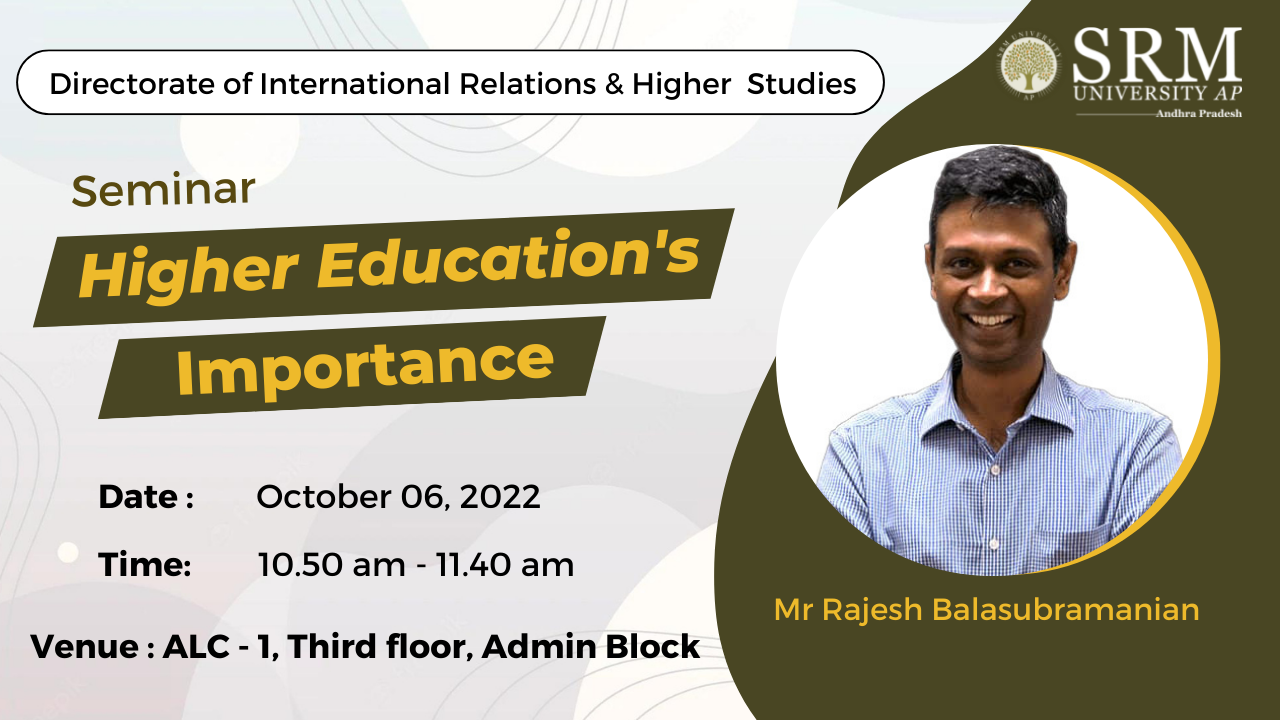
Pursuing higher education is a prerequisite for a distinctive and successful career path. The completion of tertiary education expands deep critical and reasoning skills through an experiential learning process. It also enhances employment prospects in a highly competitive job market.
The Directorate of International Relations and Higher Studies is organising a seminar on the topic Higher Education’s Importance discussing the significance of ensuing tertiary education in upskilling their knowledge assets to inflate one’s career opportunity. Mr Rajesh Balasubramanian will address the gathering.
Date : October 6, 2022
Time : 10.50 am to 11.40 am
Venue : ALC – 1, Third floor, Admin Block
The seminar would provide a brief and comprehensive outlook on the various objectives of mastering a higher degree.
- MBA as an option for Higher Education
- MBA abroad vs MBA in India
- Top B-Schools in the country and how to get admitted into these B-Schools
- The exams a candidate can take – Eg: XAT, SNAP, IIFT, GMAT, GRE.
- What is CAT? (Exam patterns and syllabus)
Speaker’s Profile
Mr Rajesh Balasubramanian is an Electrical Engineer from IIT, Madras, Class of 2001 and completed his PGDM from IIM Bangalore in 2003. He runs 2IIM’s CAT program and has built most of the content for the 2IIM CAT Online Course.
He scored 100th percentile in CAT 2011, CAT 2012, CAT 2014 and CAT 2017. Rajesh scored 99.77 in CAT 2018, 99.99th percentile in CAT 2019, 99.98th percentile in CAT 2020, and 99.79th percentile in CAT 2021.
Rajesh also runs PiVerb – an Ed-Tech company that focuses on teaching maths intuitively to students from class V to class X. Prior to his stint in education, Rajesh had spent a few years as an investment banker.
Join the seminar to anchor your dreams for higher education.
- Published in Events, International Relations, IR-Events
The Young Leaders Programme
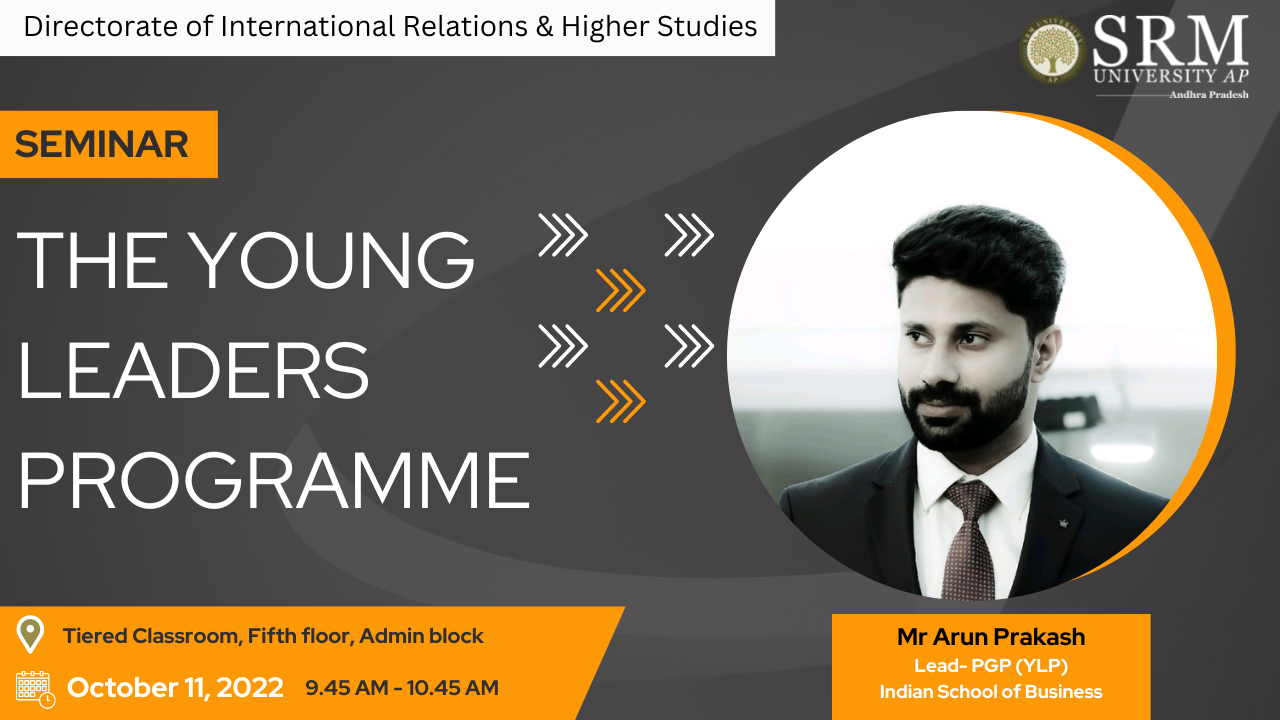 The Young Leaders Programme is a foundation that helps high-potential college students secure admission to India’s #1 MBA, the Post Graduate Programme in Management (PGP), at the Indian School of Business (ISB). The Directorate of International Relations and Higher Studies is conducting a seminar, The Young Leaders Programme, to give the students at the university a broader exposure to the programme. Renowned higher education Marketing Professional Mr.Arun Prakash will be the key speaker at the event.
The Young Leaders Programme is a foundation that helps high-potential college students secure admission to India’s #1 MBA, the Post Graduate Programme in Management (PGP), at the Indian School of Business (ISB). The Directorate of International Relations and Higher Studies is conducting a seminar, The Young Leaders Programme, to give the students at the university a broader exposure to the programme. Renowned higher education Marketing Professional Mr.Arun Prakash will be the key speaker at the event.
Date: October 11, 2022
Time: 9.45 AM to 10.45 AM
Venue: Tiered Classroom, Fifth Floor, Admin Block
The Young Leaders Programme is meant for pre-final or final year undergraduate or postgraduate students. It equips college students with multidisciplinary perspectives, thinking skills, and research tools and provides clarity on career goals before they begin the PGP in Management.
The seminar will deal with areas including ISB overview, ISB Value Proposition, PGP- YLP Overview etc. It will help students understand how to strengthen the MBA application to crack India’s #1 PGP in Management. A Q & A or discussion on MBA in India Vs MBA abroad and MS vs MBA, and much more are the other attractions of the event.
About the speaker
Mr Arun Prakash leads the Young Leaders Programme at the Indian School of Business. He has rich experience working in top brands like Naukri.com, Butterfly Appliances, and Eenadu and served in premier educational institutions in various managerial roles. His area of interest lies in Career Counselling, Marketing Strategy, Branding, Digital Marketing, Admissions, Outreach, Students’ Life, and Alumni Relations.
Join the seminar for an insightful talk!
- Published in Events, International Relations, IR-Events
Advantages of global immersion programmes in Malaysia
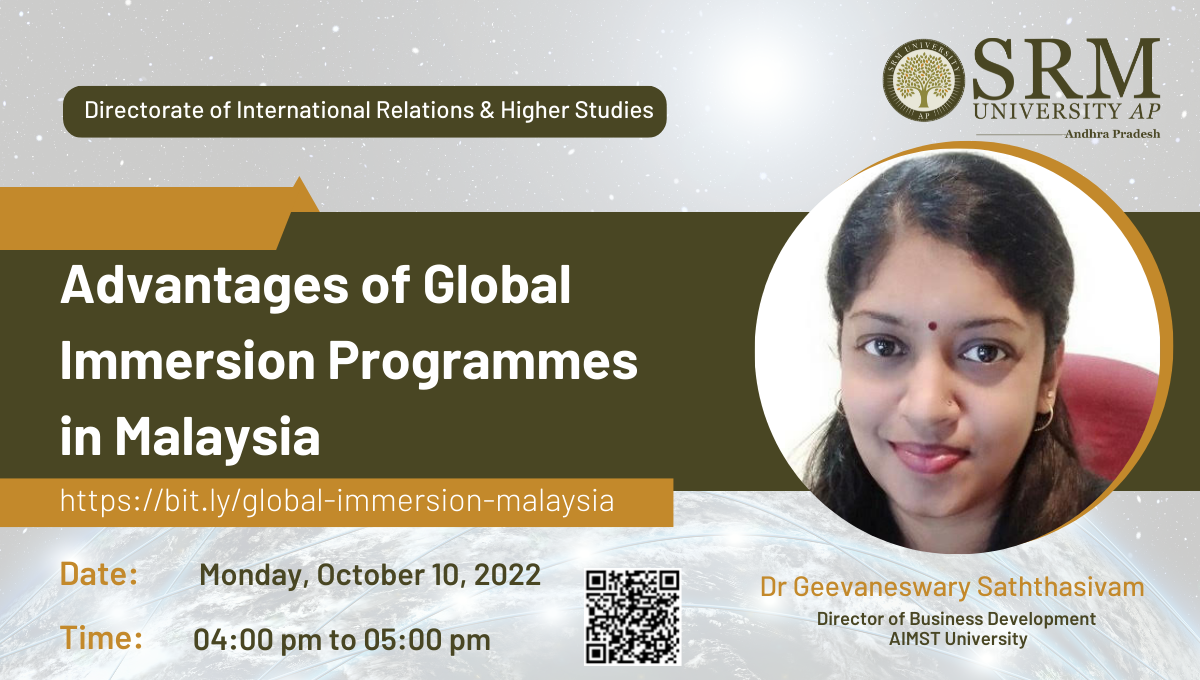 Global Immersion Programme is a unique abroad learning programme instituted at SRM University-AP, enabling students to acquire an all-encompassing learning exposure at an international university. The programme intends to acquaint students with varied approaches of learning while gaining exposure to a foreign cultural, political, and social milieu.
Global Immersion Programme is a unique abroad learning programme instituted at SRM University-AP, enabling students to acquire an all-encompassing learning exposure at an international university. The programme intends to acquaint students with varied approaches of learning while gaining exposure to a foreign cultural, political, and social milieu.
The Directorate of International Relations and Higher Studies is organising a webinar on the topic Advantages of Global Immersion Programmes in Malaysia to give students a brief overview of the Global Immersion Programmes in Malaysia and the benefits of undertaking them. Dr Geevaneswary Saththasivam, Director of Business Development, AIMST University, will be the keynote speaker for the event.
Date: October 10, 2022
Time: 4.00 pm to 5.00 pm
Speaker’s Profile
Dr Geevaneswary Saththasivam was the former lecturer and programme coordinator for UG and PG programmes from the faculty of Business and Management. Prior to that, she has 15 years of industry experience in the fields of Supply Chain Management and Shop Floor Management systems and 4 years of experience working in the field of Project Management in multinational corporations.
Join the webinar to know the prospects of doing global immersion programmes in Malaysia.
- Published in Events, International Relations, IR-Events

